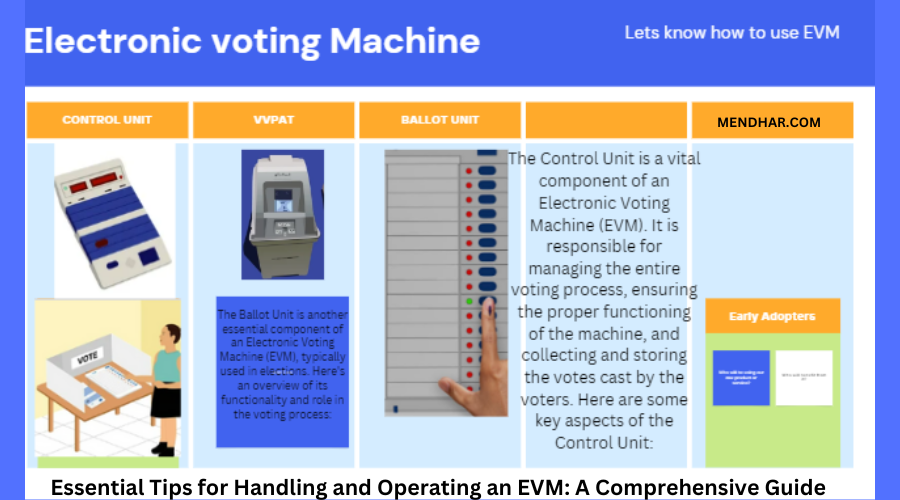Table of Contents
ToggleHandling and Operating an EVM:

In the realm of modern democracy, Electronic Voting Machines (EVMs) have revolutionized the voting process, offering efficiency, accuracy, and convenience. However, to ensure smooth elections and maintain public trust, it’s crucial to handle and operate EVMs with utmost care and proficiency. In this comprehensive guide, we’ll delve into the essential tips for effectively managing EVMs, ensuring their reliability and integrity throughout the electoral process.
Electronic Voting Machine (EVM): The Electronic Voting Machine (EVM) comprises two integral components: the Control Unit (CU) and the Ballot Unit (BU), connected by a 5-meter cable. Each Ballot Unit can accommodate up to 16 candidates, and by cascading 24 Ballot Units together, a total of 384 candidates (including the option for NOTA) can be accommodated, all controlled by a single Control Unit. Positioned adjacent to the candidates’ vote buttons on the right side of the BU are embossed Braille signages with digits 1 to 16, aiding visually impaired electors. The EVM operates on a power pack (Battery) providing 7.5 volts.
Voter Verifiable Paper Audit Trail (VVPAT): The Voter Verifiable Paper Audit Trail serves as an independent system attached to the Electronic Voting Machines, enabling voters to verify that their votes are accurately cast. The VVPAT system operates on a power pack (Battery) delivering 22.5 volts.

Handling and Operating an EVM:
Understanding the Basics: Before delving into the intricacies of handling an EVM, it’s imperative to have a solid understanding of its components and functionality. An EVM typically consists of a control unit and a balloting unit connected by a cable. Familiarize yourself with these components to operate them effectively.
Proper Storage and Transportation: EVMs are sensitive electronic devices that must be stored and transported with care. Ensure they are kept in a secure and climate-controlled environment to prevent damage from humidity or temperature fluctuations. During transportation, use designated containers and follow established protocols to prevent mishaps.
Pre-Election Checks: Before the commencement of voting, conduct thorough pre-election checks to ensure the EVMs are functioning correctly. Test each unit for responsiveness, check the battery status, and verify the seals to detect any signs of tampering. Address any issues promptly to avoid disruptions during the voting process.
Training for Operators: Proper training is paramount for the operators responsible for handling EVMs. Ensure they receive comprehensive training on operating procedures, troubleshooting common issues, and adhering to security protocols. Regular refresher courses can help reinforce their skills and keep them updated on any changes or advancements in EVM technology.
Security Measures: Implement robust security measures to safeguard EVMs against tampering or unauthorized access. Utilize tamper-evident seals, secure storage facilities, and surveillance systems to deter potential threats. Restrict access to authorized personnel only and enforce strict protocols for handling and transporting EVMs.
Calibration and Testing: Periodically calibrate and test EVMs to maintain their accuracy and reliability. Conduct calibration tests to ensure the alignment of the ballot paper and the machine interface, preventing any discrepancies in vote counting. Regular testing helps identify any technical issues early on, allowing for timely resolution.
Contingency Planning: Despite meticulous preparation, unforeseen circumstances may arise during elections. Develop robust contingency plans to address potential issues such as power outages, equipment failures, or network disruptions. Backup EVMs, power generators, and alternative communication channels can mitigate the impact of such incidents and ensure the continuity of the voting process.
Post-Election Procedures: After the conclusion of voting, follow prescribed procedures for the storage, retrieval, and tallying of EVMs. Seal the machines securely to prevent tampering and transport them to designated counting centers under strict supervision. Conduct transparent and impartial tallying processes to uphold the integrity of the electoral outcome.
Continuous Improvement: Finally, embrace a culture of continuous improvement to enhance the efficiency and integrity of the electoral process. Solicit feedback from stakeholders, analyze past performance, and implement corrective measures to address any shortcomings. By continuously refining your processes and protocols, you can ensure that EVMs remain a reliable tool for democratic elections.

Handling and Operating an EVM : Functioning of EVM and VVPAT:
- The Control Unit is entrusted to the Presiding Officer/Polling Officer, while the Ballot Unit and VVPAT are placed within the Voting Compartment.
- Upon pressing the candidate button (Blue Button) on the Ballot Unit, indicating the voter’s choice, a red light illuminates against the selected candidate’s button.
- Simultaneously, a slip is printed by the VVPAT printer, containing the serial number, name, and symbol of the chosen candidate, displayed through a transparent window for approximately 7 seconds.
- Subsequently, the printed slip automatically detaches and descends into the sealed drop-box of the VVPAT.
- Finally, a beep sound emits from the Control Unit, confirming the successful registration of the vote.
Handling and Operating an EVM : First Level Checking (FLC) of EVMs and VVPATs:
- FLC of EVMs and VVPATs is conducted prior to each election by authorized engineers from Bharat Electronics Limited (BEL) and Electronics Corporation of India Limited (ECIL) at the District Election Officer (DEO) level.
- National and State Recognized Political Parties at district headquarters are formally invited in writing by the concerned DEO at least two days before the commencement of FLC. Copies of these invitations are also sent to state headquarters.
- Representatives from National and State Recognized Political Parties actively participate in overseeing the entire FLC process.
- A higher mock poll is conducted in a randomly selected 5% of EVMs and VVPATs. This includes tallying the electronic results of EVMs with the count of VVPAT slips. The selection process involves 1200 votes in 1% of EVMs, 1000 votes in 2% of EVMs, and 500 votes in another 2% of EVMs. Political party representatives are allowed to randomly select 5% of EVMs and VVPATs for this purpose and conduct mock polls.
- The list of FLC-approved EVMs and VVPATs is shared with all National and State Recognized Political Parties.
- Representatives of National and State Recognized Political Parties are permitted to sign the seals, forms, and registers during the FLC process.

Handling and Operating an EVM : Opening and Closing Procedures for EVM Warehouses:
During periods when elections are not ongoing until the finalization of the list of contesting candidates:
- EVM-VVPAT warehouses are opened or closed for various purposes such as movement or inspection.
- These actions are carried out in the presence of representatives from National and State Recognized Political Parties.
Upon finalization of the list of contesting candidates:
- Candidates and their representatives become involved in the opening and closing procedures of EVM-VVPAT warehouses and strong rooms.
All activities related to the opening and closing of EVM warehouses/strong rooms are conducted under videography to ensure transparency and accountability.
Frequently Asked Questions (FAQ) - Handling and Operating an EVM:
1. What is an EVM, and how does it work?
– An Electronic Voting Machine (EVM) is a device used for casting and counting votes electronically during elections. It typically consists of a control unit and a balloting unit connected by a cable. Voters select their preferred candidate by pressing the corresponding button on the balloting unit, and the control unit records and tallies the votes.
2. What are the essential components of an EVM?
– The main components of an EVM include the control unit, which manages the voting process and stores the voting data, and the balloting unit, which allows voters to cast their votes securely. Additionally, EVMs feature buttons or symbols representing candidates or political parties, as well as a display screen for feedback.
3. How should EVMs be stored and transported to ensure their integrity?
– EVMs should be stored in secure, climate-controlled facilities to prevent damage from humidity or temperature fluctuations. During transportation, they should be carefully packed in designated containers and accompanied by authorized personnel to prevent tampering or mishandling.
4. What pre-election checks should be performed on EVMs?
– Before elections, EVMs should undergo thorough pre-election checks to ensure they are functioning correctly. This includes testing responsiveness, checking battery status, verifying seals for tampering, and ensuring proper alignment between the ballot paper and the machine interface.
5. How can operators be trained to handle EVMs effectively?
– Operators responsible for handling EVMs should receive comprehensive training on operating procedures, troubleshooting common issues, and adhering to security protocols. Regular refresher courses can help reinforce their skills and keep them updated on any advancements in EVM technology.
6. What security measures should be implemented to protect EVMs?
– Security measures to safeguard EVMs include utilizing tamper-evident seals, securing storage facilities with surveillance systems, restricting access to authorized personnel only, and enforcing strict protocols for handling and transporting EVMs.
7. How often should EVMs be calibrated and tested?
– EVMs should be calibrated and tested periodically to maintain their accuracy and reliability. Calibration tests ensure the alignment of the ballot paper and the machine interface, while regular testing helps identify any technical issues early on for timely resolution.
8. What contingency plans should be in place for handling EVMs during elections?
– Contingency plans should address potential issues such as power outages, equipment failures, or network disruptions. Backup EVMs, power generators, and alternative communication channels can mitigate the impact of such incidents and ensure the continuity of the voting process.
9. What post-election procedures are involved in handling EVMs?
– After voting concludes, EVMs should be securely sealed and transported to designated counting centers under strict supervision. Transparent and impartial tallying processes should be conducted to uphold the integrity of the electoral outcome.
10. How can continuous improvement be incorporated into EVM handling and operation?
– Embracing a culture of continuous improvement involves soliciting feedback from stakeholders, analyzing past performance, and implementing corrective measures to enhance the efficiency and integrity of the electoral process. By refining processes and protocols, election authorities can ensure the responsible management of EVMs for fair and transparent elections.
- You might be interested to read!
- RELATED ARTICLES:



javedhm7@gmail.com
Very informative